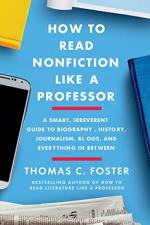
|
| Name: _________________________ | Period: ___________________ |
This quiz consists of 5 multiple choice and 5 short answer questions through Section 4: Chapter 13,"On the Stump" through Chapter 15, "Reading Internet Sources".
Multiple Choice Questions
1. What is being discussed in Chapter 10, "From the Inside Out," when Foster says that the "form and tone of the essay must fit the writer like a suit" (144)?
(a) Conflict and theme.
(b) Characterization and personality.
(c) Style and voice.
(d) Subjectivity and attachment.
2. Based on Chapter 14, "The Universe of Ideas/Ideas of the Universe," what would Foster call a neuroscientist reporting on and analyzing recent developments in neuroscience?
(a) Journalistic compilation.
(b) Amateur profiles.
(c) Interrogation of text.
(d) Expert testimony.
3. In Chapter 7, "All in How You Look at Things," Foster tells us that changing the structure of a story changes its what?
(a) Topic.
(b) Length.
(c) Genre.
(d) Meaning.
4. In Chapter 12, "Life from the Inside," Foster discusses primary and secondary sources. Which of the following would be a secondary source about World War Two?
(a) A historical account in a 2020 textbook about the attack on Pearl Harbor.
(b) A 1942 letter from an overseas American soldier to his parents.
(c) A collection of English WWII military maps and charts discovered many years after the war.
(d) An editorial in the New York Times opposing American involvement in the war.
5. In Chapter 1, "The Structure of Nonfiction Information," what does Foster say the first job of the writer is, on page one?
(a) To be clear and concise.
(b) To get the reader to page two.
(c) To create a personal bond with the reader.
(d) To tell the truth.
Short Answer Questions
1. In Chapter 2, "The Ecology of the Nonfiction Biosphere," what does Foster say is true of the sports section?
2. In Chapter 8, "Bringing the News," Foster maintains that types of newspaper writing like advice columns and human interest stories exist for what reason?
3. In "Interrogating the Text," Foster says that source material should be "apt." He means that source material should be what?
4. In Chapter 5, "It May Just Be Me, But..." what does Foster say about offering a source the chance to correct themselves if they claim that they misspoke?
5. In Chapter 12, "Life from the Inside," Foster calls Tom Brokaw's The Greatest Generation "pointillist" (179). What quality is he saying this book has?
|
This section contains 458 words (approx. 2 pages at 300 words per page) |

|




